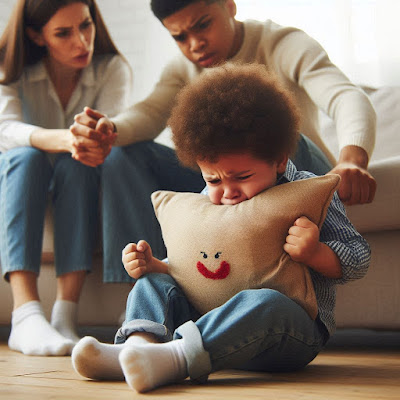Understanding and Keeping an eye on Self-Hitting Behavior in Children
Image by GoogleIntroduction
Exactly when infants and little children hit themselves when upset, it might be a disturbing sight for gatekeepers and parental figures. This approach to acting, but to some degree typical, oftentimes raises stresses over the youngster's flourishing and progression. In this article, we'll dive into the reasons for self-hitting conduct in adolescents, explore its impact on headway and flourishing, discuss systems for administering it, and give authentic advisers for address suitable techniques.
Why Do Small kids Hit Themselves?
Getting a handle on the Approach to acting: Children hitting themselves is much of the time an indication of dissatisfaction and a feebleness to convey sentiments verbally. They could rely upon genuine exercises to adjust to overwhelming feelings.
Developmental Components: Mental and significant improvement stages expect a colossal part in self-hitting conduct. Little children who have not yet totally encouraged their near and dear rule capacities could fight to manage their feelings as a matter of fact.
Significant Rule: The weakness to coordinate sentiments is immovably associated with self-hitting conduct in children. When faced with serious sentiments, for instance, shock or wretchedness, youths could go to self-hitting as a strategy for conveying quelled energy or disillusionment.
Self-Hitting Behavior in More settled Children
Image by googleChanging from Toddlerhood: While self-hitting conduct is commonly associated with small kids, it can persevere into more settled youth. Seven-year-old children and more settled may continue to hit themselves while upset, showing essential individual challenges.
Mental Components: Stress, strain, or past injury can add to self-hitting conduct in additional carefully prepared kids. These psychological factors could show up in genuine exercises as a sort of self-easing or self-control.
Social Effects: Companion associations and social components moreover expect a section in self-hitting conduct. Young people could duplicate approaches to acting they find in their companions or use self-hitting to search for thought or endorsement from others.
Signs and Symptoms
Perceiving Self-Hitting: Self-hitting behavior can take various designs, including rocking the boat in and out of town, slapping oneself, or banging body parts against objects. It's major for watchmen and parental figures to see these signs and address them speedily.
Related Approaches to acting: Nearby self-hitting, adolescents could show various signs and aftereffects, similar to withdrawal, hostility, or mental episodes. These approaches to acting can show essential significant agony and should not be overlooked.
Impact on Headway and Well-being
Genuine Outcomes: Self-hitting can incite real naughtiness, including wounds, cuts, or even power outages. The dull thought of this lead fabricates the bet of injury, highlighting the meaning of intervention.
Up close and personal Expense: The psychological effects of self-hitting on a youngster's certainty and significant thriving can be critical. Youths could experience vibes of shame, culpability, or lack, further powering their hopelessness.
Social idiosyncrasies: Self-hitting behavior can strain family associations and impact parental sensations of nervousness. Gatekeepers could feel overwhelmed or unsure of how to help their young person really, inciting expanded strain inside the family unit.
Strategies for Administering Self-Hitting Behavior
Early Mediation: Watching out for self-hitting conduct early and proactively is basic for restricting its impact. By seeing the signs and executing appropriate interventions, gatekeepers and parental figures can help youths with formulating better methods for surviving.
Elevating criticism: Supporting positive approaches to acting and showing elective strategy for practical adaptations are essential pieces of regulating self-hitting conduct. Lauding youths for using verbal correspondence or searching for help instead of hitting themselves can empower positive change.
Correspondence Strategies: Helping messes around with communicating their sentiments and put themselves out there in better ways is imperative to keeping an eye on self-hitting conduct. Engaging open trade and giving a safe space to children to impart their feelings can urge near and dear strength.
Searching for Capable Help: In circumstances where self-hitting conduct proceeds or is joined by other concerning aftereffects, it is endorsed to search for capable assistance. Counsels, educators, or direct specialists can offer specific assistance hand crafted to the youngster's necessities.
Context oriented investigations and Real Examples
Context oriented examination 1: Sarah, a three-year-old, routinely hits herself when frustrated or vexed. Her people completed procedures, for instance, showing her essential tendency words and giving unmistakable toys to help her with dealing with her sentiments as a matter of fact.
Logical examination 2: Michael, a nine-year-old, fights with self-hitting conduct due to crucial pressure. His people searched for the help of a young person clinician, who worked with Michael to perceive strategy for real life adaptations and address his own troubles.
End: Supporting Near and dear Well-being
With everything taken into account, understanding and keeping an eye on self-hitting conduct in youths requires a different procedure that spotlights on near and dear flourishing. By seeing the secret clarifications for this approach to acting, executing appropriate intercessions, and searching for capable assistance when required, gatekeepers and parental figures can help jokes around with making better ways to deal with adjusting to their sentiments.
FAQs
Q: Is self-hitting conduct ordinary in kids?
A: Some time self-hitting conduct is by and large typical, especially in children, steady or serious events could show principal individual hardships that require intervention.
Q: How should I isolate between average self-examination and precarious self-hitting conduct?
A: Run of the mill self-examination could incorporate intermittent reaching or tapping of body parts, pondering for no great explanation, however unsafe self-hitting conduct is dull, uncommon, and regularly joined by signs of torment.
Q: How might it be smart for me to answer if my young person shows self-hitting conduct?
A: Start by seeing and detailing the approach to acting, then, execute frameworks like inspiring input, correspondence strategies, and searching for capable help if basic. It's essential for approach what is the deal with compassion and determination while zeroing in on your youth's very own flourishing.




%20(3).jpeg)

%20(19).jpeg)
0 Comments